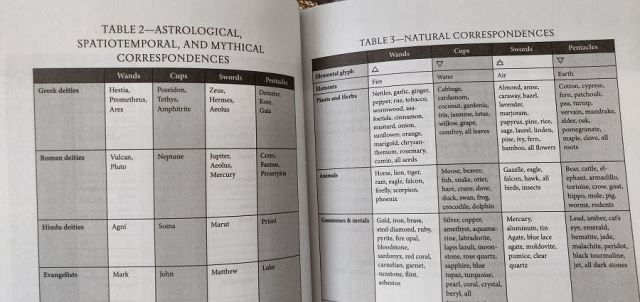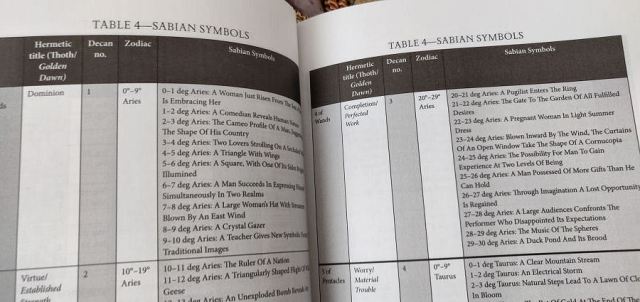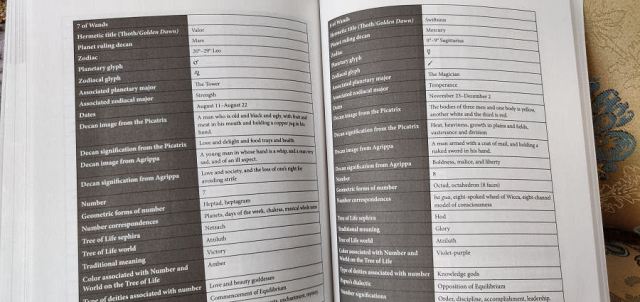This book is such a must-have. Those of you who’ve been following along in my orientation video series for Spirit Keeper’s Tarot will have seen that I recommended Tarot Correspondences as the tarot book to get if you want to work with correspondence systems.
Chang’s Tarot Correspondences is tailored to all levels of tarot proficiency, whether you’ve “been reading for decades” or “you just picked up your first deck,” (as noted in the Introduction). “Correspondences,” she writes, “are patterns and connections inherited from esoteric systems. In tarot, correspondences line up with specific cards.”
Working with tarot correspondences is premised on the doctrine of sympathy, a Hermetic principle that the way one system goes with the other is part and parcel to the magic that happens. Correspondences, notes Chang, are the bridge between worlds. And I couldn’t agree with her more.
I’m the proud owner of an Arcana Case, which Chang hand-crafts. The one you see pictured above was custom-crafted for my Tabula Mundi (Meleen) deck. I also have Aquarius from Susan’s line of Zodiac Perfumes. Even though my sun sign (horoscope sign) is Libra, I got the chance to smell all the scents at Readers Studio 2018, and my favorite one was Aquarius. Since I’m an Aquarius rising, it was an open and shut case. I went home with the bottle of Aquarius. You can check out her shop here.
In other words, I’ve always been a big fan of hers. I like to disclose biases up front when I’m doing a review, so I think me being a big fan counts as a bias.
My bias as a reviewer aside, the book’s high caliber of quality speaks for itself. The first half of the text is a delicious collection of correspondence tables with systems aligned in the ever most organized fashion to tantalize the magician.
Chang does note that her correspondences are based primarily in the Golden Dawn, as that particular schematic is at the foundation of Western ceremonial magical traditions, including Wicca, Neopaganism, and Hermetic Qabalah. Her perspective on some elements of the I Ching, ba gua, and Eastern metaphysics (there’s a small sprinkling of it in here) is also coming from a Western ceremonial and Order of the Golden Dawn perspective, which does have its differences from the native approaches to these systems (just think Hermetic Qabalah vs. the Kabbalah of Jewish mysticism).
The handbook focuses on four main systems: the elements, astrology, numerology, and Kabbalah. Yet there’s also facets of so many other systems of correspondences that Tarot Correpondences truly feels like it has aspired to be as comprehensive as practicably possible.
The text also gets in to the complementary relationship between divination and magic with the tarot. “As a magician, you don’t stop at answers [divination]. You instead invite the Empress to take charge of your affairs (or one part of them) [magic]. You call her on her day, at her hour, in her dignity and with her tokens, and you ask her for her help, please, in bringing love or peace or wealth into your life. Then you thank her, leave the room, close the door behind you…and you don’t look back.”
Structurally, the book is organized into three parts. Part One consists of correspondence tables galore. First, Chang features reference charts for the 22 Majors, then for the 4 suits, then for the 40 numeric Minors, and then the 16 court cards. Her organization is very easy to follow and much of why this book is so useful and so tantalizing to me is Chang’s organization.
These tables are a treasure trove. Anyone who wants to incorporate ritual magic of any stripe in with the tarot needs to get this book. This is how important Tarot Correspondences is to the study and practice of esoteric tarot or any form of Western ceremonial magic: if I ever were to teach such a course subject in a formalized pedagogical manner, Chang’s Tarot Correspondences would be part of the shortlist of required reading.
Part Two gets into using these correspondence systems within the scope of divination and within the scope of magic, addressing both. One of the questions I often get from folks is, “How do you use astrological correspondences in the tarot?” Well, Chang’s book will answer that question for you, and she does it so artfully that it unleashes the floodgates of your own creativity once you’ve read her outline of suggestions and instruction.
She also deep-dives into tarot and numeric correspondences, how to work with numerology and integrate it into your reading of the cards, especially when working with tarot in the scope of fortune-telling.
There are also blank tables for you to write in to follow her exercise prompts that help trigger your personal processing and understanding of the correspondence systems. I’ve heard other folks comment on how these exercise prompts in tarot text are immensely helpful to them and they always follow along with the exercises, so there’s value here for Chang to have included them.
Finally, one of the text’s greatest features is the cogent, easily digestible manner in which it explains the Kabbalah and Kabbalistic correspondences to the tarot. While there are innumerable texts on the tarot and Kabbalah’s relations to each other, I’ll be the first to confess that I find most of it too obscure and obtuse for my immediate understanding. Chang breaks it down so effortlessly that a fifth grader can read this book and come away with the basics.
To me, that’s a testament to how well Chang herself understands the material. I’ve always been taught that if you can’t explain something in plain English, then the reality is you probably don’t understand that subject well enough yourself. Chang? She understands this stuff damn well.
I also love and resonate closely with what she has to say about pathworking with the tarot, as it very much reflects my own personal approaches. Are you interested in crafting tarot talismans and amulets? What about gaining a deeper understanding into the intersection of tarot and spell-crafting? These are all topics addressed in a well-rounded manner in Tarot Correspondences.
The third part, Part Three, gets into individual card tables. Each of the 78 cards gets its own dedicated page with a comprehensive correspondence table just for that card. What Chang wrote earlier in the Introduction about calling upon the tarot Empress: find Key 3’s entry in this section and just run down the correspondence table to collect ideas for how to work your spell-crafting and ritual magic.
My only critique, or suggestion, is that for a dense reference book such as this one, where the very purpose of it is for reference, an index would have added to its usability. I kind of wish the editors at Llewellyn would have invested in producing an index for Tarot Correspondences.
These days you often hear tarot writers lamenting that everything has been done and how can you possibly write and publish a tarot book with a unique perspective or one that will add measurable value to the world of tarot publishing. Well T. Susan Chang has done just that, proving and delivering an invaluable and timeless reference tome to be cherished by Western occult practitioners across the board. Beautifully executed, rich with illustrations, diagrams, and pictorials to supplement the reading comprehension, and unequivocally establishing itself as one of the great contributions to tarot literature in this century.
![]()
FTC Disclosure: In accordance with Title 16 of the U.S. Code of Federal Regulations Part 255, “Guides Concerning Use of Endorsements and Testimonials in Advertising,” I received Tarot Correspondences: Ancient Secrets for Everyday Readers from Llewellyn Books for prospective review. Everything I’ve said here is sincere and accurately reflects my opinion of the book.












It is on my wish list. As soon as I move to my new home, I will purchase it in hard copy. I think that’s probably the best format for this.
LikeLike
Pingback: Tarot Correspondences by T. Susan Chang — benebell wen | ravenhawks' magazine
Reblogged this on ReBirth: The Pursuit of Porsha.
LikeLike
It’s such a great book! I finally finished the dense beast. Like the Zillich deck, there were a few typos that made me wonder whether certain illogical structures (like the counting of pathways) were accidental or intentional. But it’s so rich and thought-provoking that it just made me want to look into the few things that didn’t make sense for myself.
LikeLike
Pingback: Changing a Negative Reading: Create a Tarot Mandala – benebell wen
Pingback: Tarot of Magical Correspondences: A Review – benebell wen
There is an errata list on the author’s page: https://www.tsusanchang.com/book-errata
It’s no problem to add the corrections. Considering the huge amount of information in this book, the errata and typos are no big matter.
LikeLike
Pingback: The Living Tarot by T. Susan Chang – benebell wen
Pingback: StaarCon 2024 in Palm Beach, Florida – benebell wen